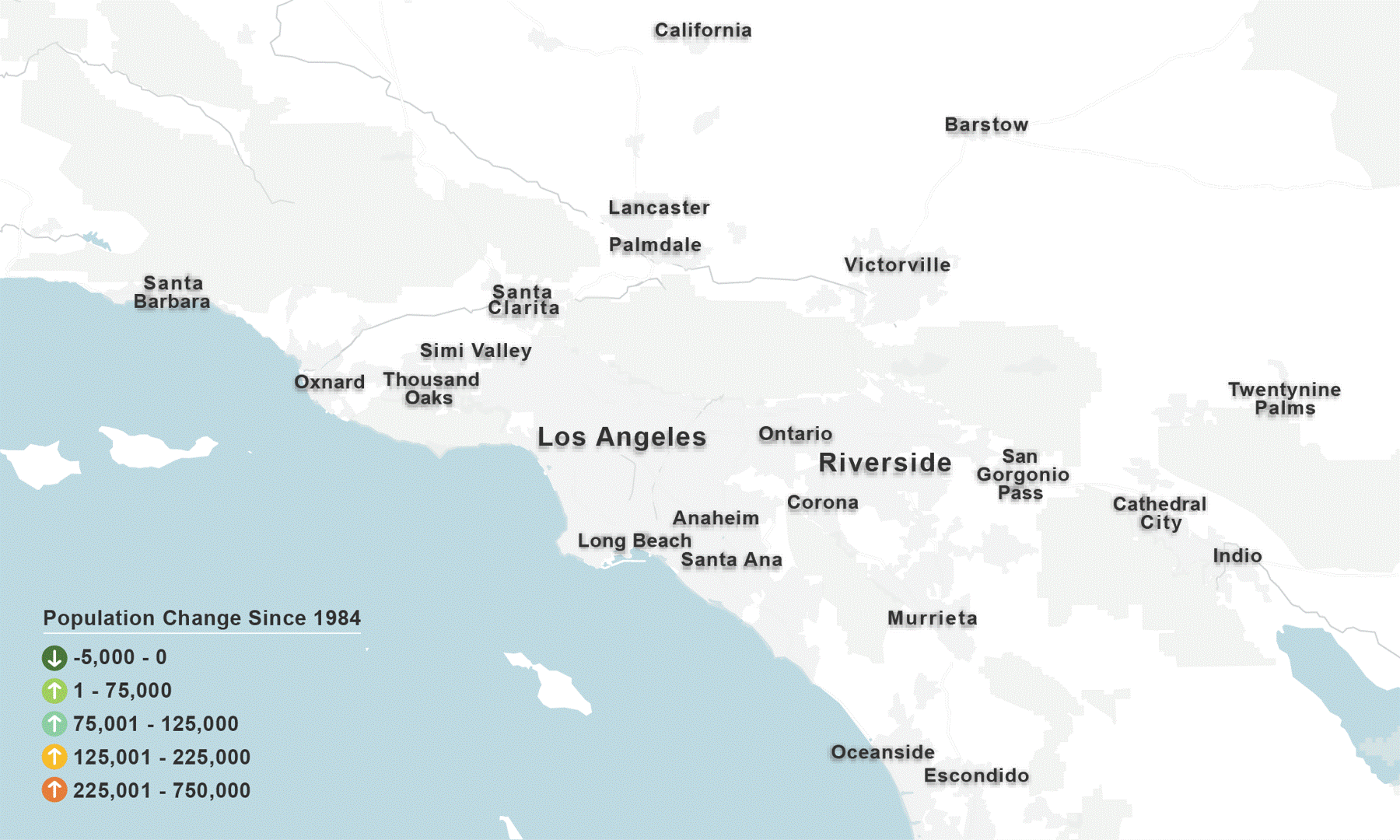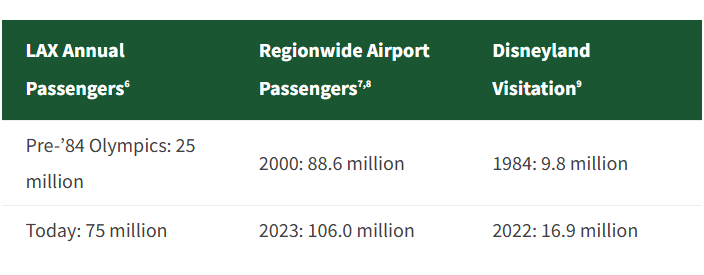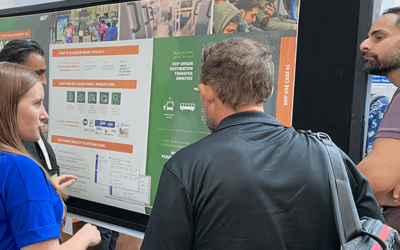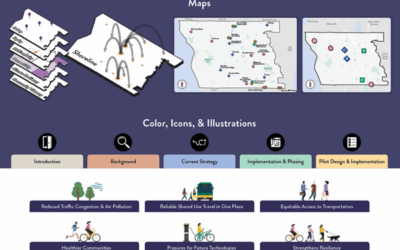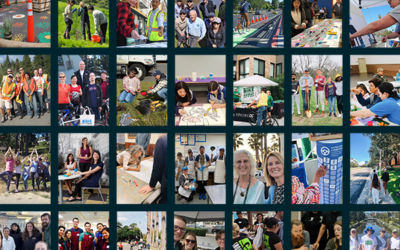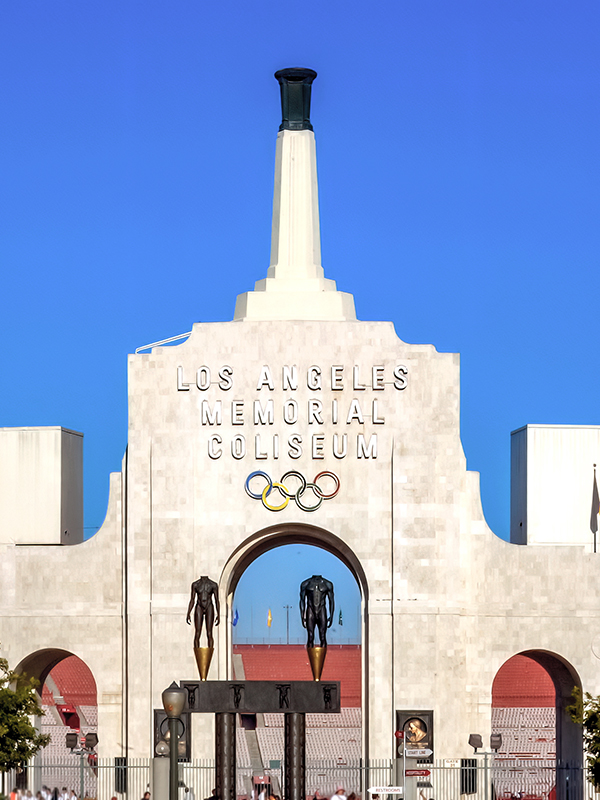
“[The 2028 Olympics & Paralympics] is the operational equivalent of seven Super Bowls a day for 30 days.”
Casey Wasserman, LA 2028 Chairman
Game-Changers Since the 80’s
The Games
- Increased Participation: The 2028 Games will host athletes from 206 countries (up from 140 in 1984), competing in over 800 events across 50+ sports (up from 221 and 21 respectively).3,4
- Transportation Demand:: An estimated 2,700 buses will be required to move spectators, athletes, media,5 compared to 550 in 1984.
Population
As the population in Southern California has grown since 1984, the regional transportation system has also grown.

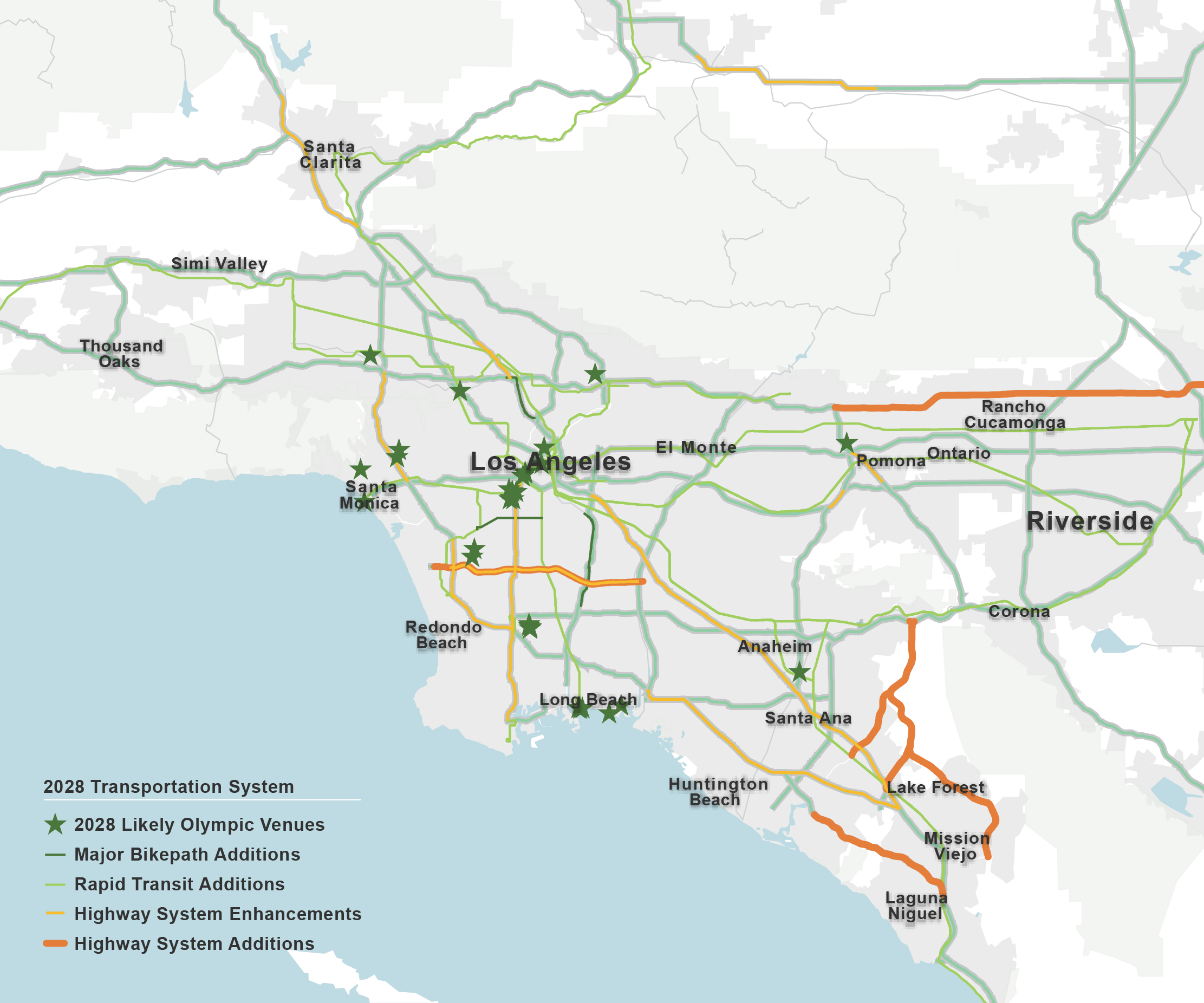
Strategies for Success:
- Maximize Existing Transit Investments: To accommodate the 2028 Games, cities must enhance connections between venues, tourist hubs, and major transit stations with first/last mile improvements and complete streets treatments. Key improvements include Metrolink enhancements through the SCORE program, speed and safety improvements on the Metro G Line, the Metro D Line extension to Westwood, and new transit connections to LAX.
- Prioritize Customer Experience: Focusing on customer experience, wayfinding, and safety will benefit both existing and new riders across the expanded system. Metro’s Mobility Concept Plan is designed to meet these needs based on a rider’s familiarity with transit and using Metro’s system. is designed to meet these needs based on a rider’s familiarity with transit and using Metro’s system.
- Invest in Community Partnerships: Work with local jurisdictions, community organizations, and transit riders to build support for accelerating project delivery that will leave legacy benefits long beyond 2028.
- Adjust Policies: Consider how to adapt policies for large event hosting and rapid infrastructure growth. Metro’s CX Action Plan and progress tracking account for over 100 miles of new rail lines and dedicated transit rights-of-way added to support games-related travel.
Tourism
Tourism has grown substantially across the region over the past 40 years, with the revitalization of Hollywood and the expansion of theme parks like Disneyland and Universal Studios.
Strategies for Success:
- Small Details Matter: Don’t overlook “acupuncture” improvements like underpass lighting, tree-planting, and community artwork to enliven a space and encourage people to walk, bike, and take transit.
- Consider All Regional Tourist Attractions: Enhance wayfinding, curbspace management, and park-once strategies to streamline visitor movement, even in places where there isn’t a formal Games-related event. Improve connections to regional transit and implement multimodal access plans, especially in busy commercial, University, and entertainment districts where tradeoffs and competing interests are most challenging. For an ambitious and thoroughly documented example, see the citywide curbspace management plan in Boulder, Colorado.
- Multimodal Transportation Strategies at Venues: Implement policies and designs that address all mobility needs, ensuring comfort and service regardless of travel mode. The Intuit Dome in Inglewood showcases an expansive multimodal planning approach. Opening in Fall 2024, and prepared to host basketball games during the 2028 Olympics & Paralympics, it will have on-site infrastructure that supports a variety of ways to arrive to the venue.
WFH percentage 1980 census vs latest ACS
- Working Remotely: Encouraging remote work for locals can help manage transportation demand during the ‘28 Games, to allow locals and tourists alike to engage in the festivities when traveling is unavoidable. Flexible work schedules drastically reduced traffic during the 1984 Olympics, and since 1980, the percentage of people who work from home has grown tenfold. Programs should promote and reward remote work, given that 39% of jobs can be done from home.12
Technology
New technologies continue to dramatically transform transportation. E-commerce and deliveries have increased local goods movement and reshaped freight distribution patterns. App-based TNCs like Uber and Lyft provide convenient ride-hailing by smartphone but have affected localized congestion and created new challenges for event and arena access patterns. These changes raise questions about how best to manage curb resources for parking, pick up and drop off, and loading activities.
Annual TNC Trips Taken in LA Country13
Strategies for Success:
- Leveraging Emerging Technologies: New technologies offer alternatives to driving. Accessing transit information through partnerships with vendors and mobile apps will be crucial during the games. Similar to the 1984 Olympics, where over 30% of businesses changed their delivery patterns to reduce congestion14, jurisdictions can explore time-of-day policies with e-commerce providers and local businesses. Planning for micromobility, autonomous vehicles, and new modes like urban air mobility should all be considered. While some venues have robust TNC and transit access protocols in place, many do not, and new security and access controls during the Games represent an opportunity to update visitor access strategies and apply promising tech innovations.
- Evaluating and Applying New Data Sources: Tools and resources like the LADOT Transportation Technology Strategy partnership evaluation rubric, Driver seat data on TNC activity, survey research for the Clippers’ arrival patterns, and pickup and drop-off management changes at the Hollywood Bowl can help evaluate system changes quickly and effectively.
- Testing Innovations: We recently helped Supernal explore vertiport siting by combining several big data sets. The ’28 Games offer a prime opportunity for new mobility vendors to test new data analysis and concepts, leveraging the excitement and captive audience to showcase innovations.
Accommodation
Airbnb and VRBO, which didn’t exist in 1984, mix tourism uses directly into residential communities. These platforms offer new opportunities for jurisdictions and event coordinators to promote alternative mobility options.
Hotels15 vs Airbnbs16 in LA County
Strategies for Success:
- Information Distribution: Collaborate with platforms to share information about discounted transit or bike share passes with visitors before and during their stays. Given that expanded lodging options follow a decentralized pattern throughout the region, more creative ways to disseminate information will be necessary.
- Transit Directions: Provide listing-customized transit directions to and from nearby airports and train stations through accommodations platforms, encouraging the use of public transport.
- Pre-Arrival Engagement: Engage with visitors prior to their arrival to inform them about alternative mobility options, reducing the reliance on private automobile travel.
Catch Us in Paris:
Whether you’re a city, transit agency, venue manager, or community group, we’ve gathered key insights and lessons from our decades of transportation planning and implementation in Los Angeles and beyond. Let us help you align your multimodal strategy effectively.
1 https://www.latimes.com/sports/olympics/story/2023-12-20/la28-confident-fundraising-billions-2028-summer-olympics
2 https://archive.curbed.com/2018/5/17/17359086/olympics-2028-los-angeles-1984
3 https://olympics.com/en/olympic-games/los-angeles-1984
4 https://la28.org
5 LA Metro
6 https://www.businessinsider.com/photos-of-crowds-at-lax-in-the-1980s-2015-12#the-airport-has-only-grown-more-crowded-over-time-while-in-1978-lax-handled-roughly-28-million-passengers-in-2014-an-astounding-707-million-passengers-passed-through-12
7 https://scag.ca.gov/sites/main/files/file-attachments/data_sheet_-_scag_region.pdf?1614041150
8 FAA
9 https://jansworld.net/disney-ticket-history
10 1980 US Census
11 2022 American Community Survey
12 https://www.pewresearch.org/short-reads/2023/03/30/about-a-third-of-us-workers-who-can-work-from-home-do-so-all-the-time/
13 https://tncs2020.sfcta.org/ch3_general/
14 LA 84 Impacts Report, 1985, p. 139
15 https://www.discoverlosangeles.com/media/facts-about-la
16 https://www.statista.com/statistics/1339477/number-airbnb-listings-selected-cities-us/
share this article
Contributors
Explore More
Join Us at ITE Western 2025 | June 29-July 2
We are looking forward to joining peers across the region at the 2025 ITE Western District Annual Meeting to share ideas, practical tools, and approaches that support safer, more inclusive transportation systems.
Mobility Hubs for Everyone
We partnered with the City of Shoreline to bring shared-use mobility hubs to life through visual storytelling—making sustainable, people-first travel easier to understand, support, and implement.
Celebrating 40 Years of Moving Communities Forward
In 1985, Juergen Fehr and Jack Peers set out to build a different kind of transportation consulting firm—one that empowered its people and focused on improving communities through innovation and creativity.

